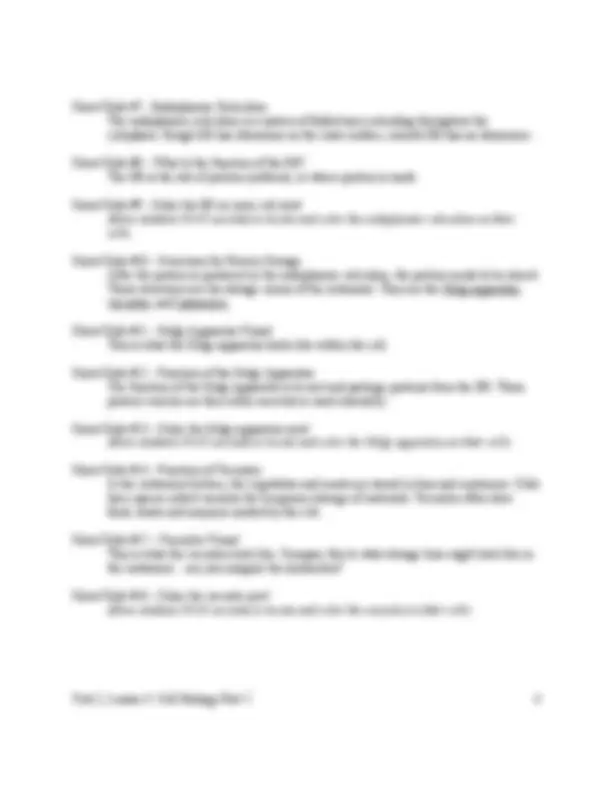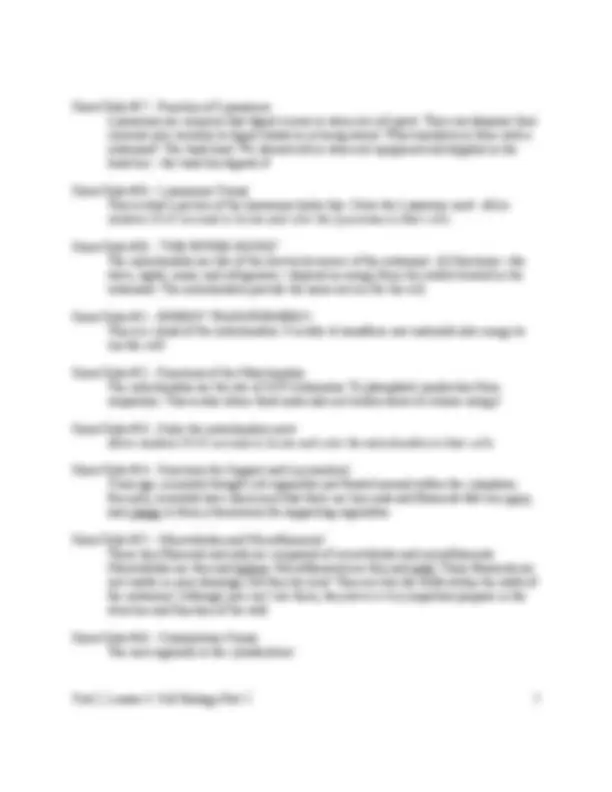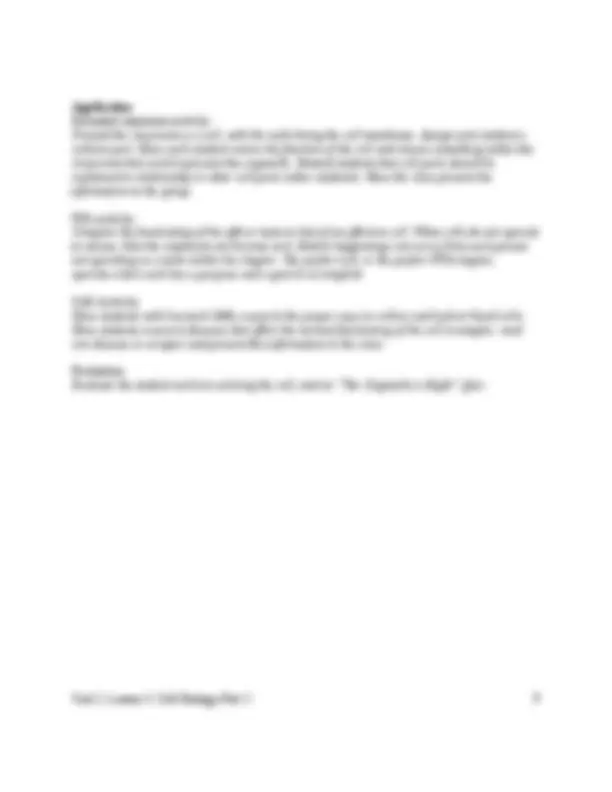










Study with the several resources on Docsity

Earn points by helping other students or get them with a premium plan


Prepare for your exams
Study with the several resources on Docsity

Earn points to download
Earn points by helping other students or get them with a premium plan
Community
Ask the community for help and clear up your study doubts
Discover the best universities in your country according to Docsity users
Free resources
Download our free guides on studying techniques, anxiety management strategies, and thesis advice from Docsity tutors
Biology of the Animal Cell lesson activity questions and answers key
Typology: Exercises
1 / 14

This page cannot be seen from the preview
Don't miss anything!









Section: Animal Science
Unit: Unit 5: Cell Structure and Function
Lesson Title: Lesson 3: Biology of the Animal Cell 2 “Setting Our Cytes Ahead”
Student Learning Objectives As a result of this lesson, the student will:
Resources/References
Tools, Equipment, and Supplies Handouts Colored Pencils Calculators
Key Terms Plasma membrane Cell wall Chlorophyll Chromatin Nucleus Cytoskeleton Ribosome Microtubule Cytoplasm Microfilament Endoplasmic reticulum Cilia Golgi apparatus Flagella Vacuole Lysosome Mitochondria
Interest Approach Have the PowerPoint, “Setting your Cytes Ahead,” 2 on the screen when you begin. Start by reviewing the previous two lessons.
As we continue our lesson on the parts of an animal cell, let’s review why cells are so amazing. Ask the following questions:
Excellent job! I am impressed at what you know. If some of you feel like this is not making sense, or you are not sure of the answers, you need to go back and visit some of your notes because you can expect to see these questions again on a future test.
Show Slide #7 - Endoplasmic Reticulum The endoplasmic reticulum is a system of folded sacs extending throughout the cytoplasm. Rough ER has ribosomes on the outer surface; smooth ER has no ribosomes.
Show Slide #8 – What is the function of the ER? The ER is the site of protein synthesis, or where protein is made.
Show Slide #9 - Color the ER on your cell now! Allow students 30-45 seconds to locate and color the endoplasmic reticulum on their cells.
Show Slide #10 - Structures for Protein Storage After the protein is produced in the endoplasmic reticulum, the protein needs to be stored. These structures are the storage rooms of the restaurant. They are the Golgi apparatus, vacuoles, and lysosomes.
Show Slide #11 - Golgi Apparatus Visual This is what the Golgi apparatus looks like within the cell.
Show Slide #12 - Function of the Golgi Apparatus The function of the Golgi apparatus is to sort and package proteins from the ER. These protein vesicles are then either secreted or used internally.
Show Slide #13 - Color the Golgi apparatus now! Allow students 30-45 seconds to locate and color the Golgi apparatus on their cells.
Show Slide #14 - Function of Vacuoles In the restaurant kitchen, the vegetables and meats are stored in bins and containers. Cells have spaces called vacuoles for temporary storage of materials. Vacuoles often store food, waste and enzymes needed by the cell.
Show Slide #15 – Vacuoles Visual This is what the vacuoles look like. Compare this to what storage bins might look like in the restaurant…can you imagine the similarities?
Show Slide #16 - Color the vacuole now! Allow students 30-45 seconds to locate and color the vacuoles in their cells.
Show Slide #17 - Function of Lysosomes Lysosomes are enzymes that digest excess or worn out cell parts. They can dispense their contents into vacuoles to digest whatever is being stored. What similarity is there with a restaurant? The trash bins! We discard old or worn out equipment and supplies in the trash bin – the trash bin digests it!
Show Slide #18 – Lysosomes Visual This is what a picture of the lysosomes looks like. Color the Lysosome now! Allow students 30-45 seconds to locate and color the Lysosomes in their cells.
Show Slide #20 - “THE POWER HOUSE” The mitochondria are like of the electricity source of the restaurant. All functions—the stove, lights, music and refrigerator—depend on energy from the outlets located in the restaurant. The mitochondria provide the same service for the cell.
Show Slide #21 - ENERGY TRANSFORMERS!! This is a visual of the mitochondria. It is able to transform raw materials into energy to run the cell!
Show Slide #22 - Functions of the Mitochondria The mitochondria are the site of ATP (Adenosine Tri phosphate) production from respiration. This is also where food molecules are broken down to release energy!
Show Slide #23 - Color the mitochondria now! Allow students 30-45 seconds to locate and color the mitochondria in their cells.
Show Slide #24 - Structures for Support and Locomotion! Years ago, scientists thought cell organelles just floated around within the cytoplasm. Recently, scientists have discovered that there are tiny rods and filaments that can move and change to form a framework for supporting organelles.
Show Slide #25 – Microtubules and Microfilaments! These tiny filaments and rods are composed of microtubules and microfilaments Microtubules are thin and hollow. Microfilaments are thin and solid. These filaments are not visible in your drawings, but they do exist! They are like the studs within the walls of the restaurant. Although you can’t see them, they serve a very important purpose in the structure and function of the wall.
Show Slide #26 – Cytoskeleton Visual The next organelle is the cytoskeleton!
EXCELLENT JOB! There were 22 possible points. Please pass in your quizzes and colorings for credit. Remember—cells are the smallest living units of an organism. They are small, but have an incredible amount of form to their function. Each organelle in the cell has specific functions for cell maintenance, work and reproduction. Each cell provides specific functions to assist the organism as a whole.
Now does anybody have questions or clarification about the animal cell and its function? If so, answer, if not, move on to the laboratory session.
Objective 2. Select and use appropriate technologies to gather, process and analyze data and to report information related to an investigation. We are now going to practice working with our microscopes and preparing slides so that we can view cell organelles. Remember, in order to see most organelles, we would need a microscope much stronger than those found here. However, let’s see what we can see by working on the Cheek Cell Lab.
Students will be looking at their own cheek cells under a microscope. This lab will take around 30 - 40 minutes, depending on how many students and microscopes you have. Read through the lab before hand to get an idea of the procedure. Set up the lab before you begin the lecture so you can move right into the lab portion at the end of the last slide. Make sure there are plenty of supplies and everything is well marked!
Give each student a copy of the laboratory handout, “What do your Cheek Cells Look Like?”
To see first hand what your cells look like, we will examine one of your cells and you will draw a picture of the cell, label its parts and answer a few questions regarding the process and what you see. I’ll need your full focus as I model how this should be done.
(Have steps and procedure up on the board for reference)
Due to lack of enough lab tools and equipment and the fact that they can divide and conquer, keep students working in pairs.
Go through the procedure worksheet step by step, modeling the way it is to be done. Emphasize safety and proper lab technique. At the end of your demonstration, tell the students to ask for help if they have questions. Remind them of the timeline and to complete the student lab worksheet and hand it in before the period is over, then clean up their station. See Teacher Notes page at the end of this lesson plan.
Okay, you may begin! ( Be on hand to watch and answer questions and monitor student work). After completing the lab, ask the following questions: What was the most difficult thing about this lab?
How many of you were able to see individual cheek cells? If you weren’t able to see them, what went wrong? Those of you who were able to see the cheek cells, what organelles were present? Why were some of the organelles not present?
Answers to Assessment: Answer key to the “Organelle Is Right” Quiz
_1. Cell Membrane
Name:
Write the correct name of the organelle on the screen. You will have 5 seconds to do so for each organelle. Good Luck!
Cheek Cell Lab Worksheet
Teacher Notes
Objective: Observe cheek cells under a microscope. Level: 9- Subjects: Life science, Biology Prep Time: 10-20 minutes Duration: 30-40 minutes
Materials
Tooth picks or cotton swabs Microscope Glass slides and covers Iodine or Methylene Blue Eye droppers Paper towels Forceps Student worksheets
Extensions : Can use onion or blood cells as well.
Pre-lesson instructions : Have students work in groups of at least two for this lesson. Each group will need a microscope and materials to create a slide of cheek cells.
Set up microscopes in a laboratory setting. Create a mixture of Methylene Blue in droppers ahead of time and label. (Warn students about the effects of stain.) Note that this lesson is an extension of the previous lessons on the cell and its parts.
Model the entire procedure after all the students have their worksheets and are in groups. Ask if there are any questions.
I sometimes find it necessary to stop the lab and discuss a teachable moment or a problem with the process if all the groups are having difficulty.
Discussion / Wrap up: Have the students share their diagrams with the class. Discuss the diagrams as a class. Were the students surprised by what they saw? Why was the stain important? What difference did the power setting make in seeing their cells?